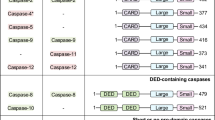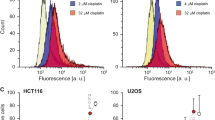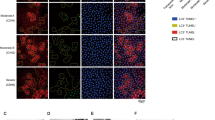Abstract
The apoptosis of lens epithelial cells has been proposed as the common basis of cataract formation, with oxidative stress as the major cause. This study was performed to investigate the protective effect of the herbal constituent parthenolide against oxidative stress-induced apoptosis of human lens epithelial (HLE) cells and the possible molecular mechanisms involved. HLE cells (SRA01-04) were incubated with 50 μM H2O2 in the absence or presence of different doses of parthenolide (10, 20 and 50 μM). To study apoptosis, the cells were assessed by morphologic examination and Annexin V-propidium iodide double staining flow cytometry; to investigate the underlying molecular mechanisms, the expression of caspase-3 and caspase-9 were assayed by Western blot and quantitative RT-PCR, and the activities of caspase-3 and caspase-9 were measured by a Chemicon caspase colorimetric activity assay kit. Stimulated with H2O2 for 18 h, a high fraction of HLE cells underwent apoptosis, while in the presence of parthenolide of different concentrations, dose-dependent blocking of HLE cell apoptosis was observed. The expression of caspase-3 and caspase-9 induced by H2O2 in HLE cells was significantly reduced by parthenolide both at the protein and mRNA levels, and the activation of caspase-3 and caspase-9 was also suppressed by parthenolide in a dose-dependent manner. In conclusion, parthenolide prevents HLE cells from oxidative stress-induced apoptosis through inhibition of the activation of caspase-3 and caspase-9, suggesting a potential protective effect against cataract formation.
Similar content being viewed by others
Log in or create a free account to read this content
Gain free access to this article, as well as selected content from this journal and more on nature.com
or
References
Resnikoff S, Pascolini D, Etya'ale D, et al. Global data on visual impairment in the year 2002. Bull World Health Organ 2004; 82:844–851.
Ottonello S, Foroni C, Carta A, Petrucco S, Maraini G . Oxidative stress and age-related cataract. Ophthalmologica, 214:78–85.
Spector A . Oxidative stress-induced cataract: mechanism of action. FASEB J 1995; 9:1173–1182.
Truscott RJ . Age-related nuclear cataract-oxidation is the key. Exp Eye Res 2005; 80:709–725.
Li WC, Kuszak JR, Dunn K, et al. Lens epithelial cell apoptosis appears to be a common cellular basis for non-congenital cataract development in humans and animals. J Cell Biol 1995; 130:169–181.
Li WC, Spector A . Lens epithelial cell apoptosis is an early event in the development of UVB-induced cataract. Free Radical Biol Med 1996; 20:301–311.
Green K . Free radicals and aging of anterior segment tissues of the eye: a hypothesis. Ophthalmic Res 1995; 27 Suppl 1:143–149.
Spector A, Garner WH . Hydrogen peroxide and human cataract. Exp Eye Res 1981; 33:673–681.
Cornish KM, Williamson G, Sanderson J . Quercetin metabolism in the lens: role in inhibition of hydrogen peroxide induced cataract. Free Radical Biol Med 2002; 33:63–70.
Petersen A, Zetterberg M, Sjostrand J, Palsson AZ, Karlsson JO . Potential protective effects of NSAIDs/ASA in oxidatively stressed human lens epithelial cells and intact mouse lenses in culture. Ophthalmic Res 2005; 37:318–327.
Yang Y, Sharma R, Cheng JZ, et al. Protection of HLE B-3 cells against hydrogen peroxide- and naphthalene-induced lipid peroxidation and apoptosis by transfection with hGSTA1 and hGSTA2. Invest Ophthalmol Vis Sci 2002; 43:434–445.
Mao YW, Xiang H, Wang J, Korsmeyer S, Reddan J, Li DW . Human bcl-2 gene attenuates the ability of rabbit lens epithelial cells against H2O2-induced apoptosis through down-regulation of the alpha B-crystallin gene. J Biol Chem 2001; 276, 43435–43445.
Tamada, Y, Fukiage C, Nakamura Y, et al. Evidence for apoptosis in the selenite rat model of cataract. Biochem Biophys Res Commun 2000; 275:300–306.
Yao K, Wang K, Xu W, Sun Z, Shentu X, Qiu P . Caspase 3 and its inhibitor Ac-DEVD-CHO in rat lens epithelial cell apoptosis induced by hydrogen in vitro. Chin Med J (Engl) 2003; 116:1034–1038.
Li-Weber M, Palfi K, Giaisi M, Krammer PH . Dual role of the anti-inflammatory sesquiterpene lactone: regulation of life and death by parthenolide. Cell Death Differ 2005; 12:408–409.
Beranek, JT . Sesquiterpene lactone parthenolide, an inhibitor of IkappaB kinase complex and nuclear factor-kappaB, exerts beneficial effects in myocardial reperfusion injury. Shock 2002; 17(2):127–134; 2003; 19:191–192; author reply 192.
Li-Weber M, Giaisi M, Baumann S, Treiber MK Krammer PH . The anti-inflammatory sesquiterpene lactone parthenolide suppresses CD95-mediated activation-induced-cell-death in T-cells. Cell Death Differ 2002; 9:1256–1265.
Nakshatri H, Rice SE, Bhat-Nakshatri P . Antitumor agent parthenolide reverses resistance of breast cancer cells to tumor necrosis factor-related apoptosis-inducing ligand through sustained activation of c-Jun N-terminal kinase. Oncogene 2004; 23:7330–7344.
Pozarowski P, Halicka DH, Darzynkiewicz Z . Cell cycle effects and caspase-dependent and independent death of HL-60 and Jurkat cells treated with the inhibitor of NF-kappaB parthenolide. Cell Cycle 2003; 2:377–383.
Pozarowski P, Halicka DH, Darzynkiewicz Z . NF-kappaB inhibitor sesquiterpene parthenolide induces concurrently atypical apoptosis and cell necrosis: difficulties in identification of dead cells in such cultures. Cytometry A 2003; 54:118–124.
Wen J, You KR, Lee SY, Song CH, Kim DG . Oxidative stress-mediated apoptosis. The anticancer effect of the sesquiterpene lactone parthenolide. J Biol Chem 2002; 277:38954–38964.
Herrera F, Martin V, Rodriguez-Blanco J, Garcia-Santos G, Antolin I, Rodriguez C . Intracellular redox state regulation by parthenolide. Biochem Biophys Res Commun 2005; 332:321–325.
Ibaraki N, Chen SC, Lin LR, Okamoto H, Pipas JM, Reddy VN . Human lens epithelial cell line. Exp Eye Res 1998; 67:577–585.
Fumarola C, Guidotti GG . Stress-induced apoptosis: toward a symmetry with receptor-mediated cell death. Apoptosis 2004; 9:77–82.
Li P, Nijhawan D, Budihardjo I, et al. Cytochrome c and dATP-dependent formation of Apaf-1/caspase 9 complex initiates an apoptotic protease cascade. Cell 1997; 91:479–489
Kuida K, Haydar TF, Kuan CY, et al. Reduced apoptosis and cytochrome c-mediated caspase activation in mice lacking caspase 9. Cell 1998; 94:325–337.
Acknowledgements
This work was supported by National Natural Science Foundation of China (No. 30471538) and Traditional Chinese Medicine Foundation of Zhejiang province (No. 2005C086). Pacific Edit reviewed the manuscript prior to submission.
Author information
Authors and Affiliations
Corresponding author
Rights and permissions
About this article
Cite this article
Yao, H., Tang, X., Shao, X. et al. Parthenolide protects human lens epithelial cells from oxidative stress-induced apoptosis via inhibition of activation of caspase-3 and caspase-9. Cell Res 17, 565–571 (2007). https://doi.org/10.1038/cr.2007.6
Received:
Revised:
Accepted:
Published:
Issue date:
DOI: https://doi.org/10.1038/cr.2007.6
Keywords
This article is cited by
-
Phototoxicity of environmental radiations in human lens: revisiting the pathogenesis of UV-induced cataract
Graefe's Archive for Clinical and Experimental Ophthalmology (2019)
-
Inhibition of p38 mitogen-activated protein kinase phosphorylation decreases H2O2-induced apoptosis in human lens epithelial cells
Graefe's Archive for Clinical and Experimental Ophthalmology (2015)
-
Caspase-8 Mediates Amyloid-β-induced Apoptosis in Differentiated PC12 Cells
Journal of Molecular Neuroscience (2015)
-
The mechanism of UVB irradiation induced-apoptosis in cataract
Molecular and Cellular Biochemistry (2015)
-
The Effect of Docosahexaenoic Acid on Visual Evoked Potentials in a Mouse Model of Parkinson’s Disease: The Role of Cyclooxygenase-2 and Nuclear Factor Kappa-B
Neurotoxicity Research (2011)



